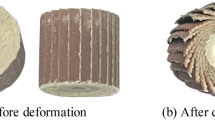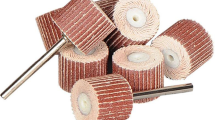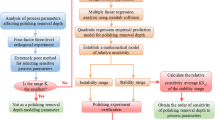Abstract
In order to use abrasive tools more effectively, it is important to understand their working capability. As a complex, fully-compliant abrasive polishing tool, the tool influence function (TIF) of the abrasive cloth flap wheel (ACFW) has not been studied and modeled. Experimental testing and data analysis was conducted to analyze the variations in the shape of the TIF, maximum material removal depth, material removal volume, and the average offset of the TIF with key process parameters for dry and wet polishing. A TIF experimental model for ACFW polishing was developed using cubic polynomial surface fitting and coefficient regression. Further, based on the principle of curvilinear integration, the cross-sectional profile of single-line polishing with various relative feed angles is accurately simulated, and the influence of the micro-topography in the TIF on the simulation results is discussed. Moreover, a method is proposed for the optimal selection of polishing path spacing and feed rate. Based on the established TIF model and single-line polished section profile calculation, cumulative removal profile simulations and parameter calculation with different polishing line spacing are carried out to select the combination of parameters with the maximum polishing efficiency within the constraints of material removal depth and its uniformity. The results of the validation experiments show that around the optimal parameter combination, the simulated profile follows the same trend as the peak-to-valley (PV) value of the measured profile, and the relative error between the cumulative material removal depth and the target value does not exceed 5%. These research findings establish a foundation and guidance for the more efficient utilization of the ACFW abrasive tool.
























Similar content being viewed by others
Data availability
The datasets analyzed during the current study are available from the corresponding author on reasonable request.
Abbreviations
- TIF:
-
Tool influence function
- ACFW:
-
Abrasive cloth flap wheel
- PV:
-
Peak-to-valley
- TPR_error:
-
Tool path ripple error
- MRV:
-
Material removal volume
- MRD:
-
Material removal depth
- RMSE:
-
Root mean squared error
- MCS:
-
Measuring coordinate system
- WLCS:
-
Workpiece local coordinate system
- MRA:
-
Material removal amount
- TPS:
-
Tool path spacing
- CRD:
-
Cumulative removal depth
- k :
-
Preston coefficient
- p :
-
Pressure at the contact position
- v :
-
Relative polishing velocity at the contact position
- t :
-
Polishing time
- n :
-
Rotation speed
- R N :
-
Nominal radius of the ACFW
- R n :
-
Radius of the ACFW with rotation speed n
- R c :
-
Normal distance between the axis of ACFW and the workpiece surface
- Δs :
-
Compression amount of the ACFW
- δ x :
-
Spacing of the point cloud in the x directions
- δ y :
-
Spacing of the point cloud in the y directions
- ε :
-
Threshold value used to exclude unpolished points
- t d :
-
Dwell time of the experimental test
- θ :
-
Angle between the direction of the tool axis and the direction of feed
- v f :
-
Feed rate
- ΔH :
-
Polishing allowance left by the previous process
- W s :
-
Width of profile
- η :
-
Threshold of PV value
References
Ren L, Zhang G, Zhang L, Zhang Z, Huang Y (2019) Modelling and investigation of material removal profile for computer controlled ultra-precision polishing. Precis Eng 55:144–153. https://doi.org/10.1016/j.precisioneng.2018.08.020
Chaves-Jacob J, Beaucamp A, Zhu W, Kono D, Linares J-M (2021) Towards an understanding of surface finishing with compliant tools using a fast and accurate simulation method. Int J Mach Tool Manu 163(9–12):103704. https://doi.org/10.1016/j.ijmachtools.2021.103704
Youngworth RN, Gallagher BB, Stamper BL (2005) An overview of power spectral density (PSD) calculations. Opt Manuf Testing VI 5869:206–216. https://doi.org/10.1117/12.618478
Suder KL, Chima RV, Strazisar AJ, Roberts WB (1995) The effect of adding roughness and thickness to a transonic axial compressor rotor. J Turbomach 117(4):491–505. https://doi.org/10.1115/1.2836561
Aikens DM, Wolfe CR, Lawson JK (1995) The use of power spectral density (PSD) functions in specifying optics for the National Ignition Facility. Int Conf Opt Fabrication Testing 2576:281–292. https://doi.org/10.1117/12.215604
Peng W, Guan C, Li S (2013) Material removal mode affected by the particle size in fluid jet polishing. Appl Optics 52(33):7927–7933. https://doi.org/10.1364/AO.52.007927
Jones RA (1977) Optimization of computer controlled polishing. Appl Optics 16(1):218–224
Jones RA (1986) Computer controlled optical surfacing with orbital tool motion. Proc SPIE - The Int Soc Opt Eng 550:87–95
Lu A, Jin T, Guo Z, Qu M, Chang Y, Liu Q, Zhang C (2018) Characterization of the tool influence function in a dual-axis wheel polishing process to achieve high material removal rates. Precis Eng 52:276–290. https://doi.org/10.1016/j.precisioneng.2018.01.003
Walker D, Brooks D, King A, Freeman R, Kim SW (2003) The “Precessions” tooling for polishing and figuring flat, spherical and aspheric surfaces. Opt Express 11(8):958–964. https://doi.org/10.1364/OE.11.000958
Wang C, Yang W, Wang Z, Yang X, Sun Z, Zhong B, Pan R, Yang P, Guo Y, Xu Q (2014) Highly efficient deterministic polishing using a semirigid bonnet. Opt Eng 53(9):095102. https://doi.org/10.1117/1.OE.53.9.095102
Cao ZC, Cheung CF, Zhao X (2016) A theoretical and experimental investigation of material removal characteristics and surface generation in bonnet polishing. Wear 360:137–146. https://doi.org/10.1016/j.wear.2016.03.025
Cao ZC, Cheung CF, Ho LT, Liu MY (2017) Theoretical and experimental investigation of surface generation in swing precess bonnet polishing of complex three-dimensional structured surfaces. Precis Eng 50:361–371. https://doi.org/10.1016/j.precisioneng.2017.06.010
Lu A, Jin T, Liu Q, Guo Z, Qu M, Luo H, Han M (2019) Modeling and prediction of surface topography and surface roughness in dual-axis wheel polishing of optical glass. Int J Mach Tool Manu 137:13–29. https://doi.org/10.1016/j.ijmachtools.2018.10.001
He Y, Xiao G, Zhu S, Liu G, Liu Z, Deng Z (2023) Surface formation in laser-assisted grinding high-strength alloys. Int J Machine Tools Manuf 186:104002. https://doi.org/10.1016/j.ijmachtools.2023.104002
Lin J, Wang C, Ye H, Yang W, Guo Y (2015) Effect of the tool influence function shape of the semirigid bonnet to the tool path ripple error. Opt Eng 54(11):115104. https://doi.org/10.1117/1.OE.54.11.115104
Pan R, Zhong B, Chen D, Wang Z, Wei S (2018) Modification of tool influence function of bonnet polishing based on interfacial friction coefficient. Int J Mach Tool Manu 124:43–52. https://doi.org/10.1016/j.ijmachtools.2017.09.003
Wan S, Zhang X, Zhang H, Xu M, Jiang X (2018) Modeling and analysis of sub-aperture tool influence functions for polishing curved surfaces. Precis Eng 51:415–425. https://doi.org/10.1016/j.precisioneng.2017.09.013
Wang C, Yang W, Wang Z, Yang X, Hu C, Zhong B, Guo Y, Xu Q (2014) Dwell-time algorithm for polishing large optics. Appl Optics 53(21):4752–4760. https://doi.org/10.1364/AO.53.004752
Yang M (2001) Dwell time algorithm for computer-controlled polishing of small axis-symmetrical aspherical lens mold. Opt Eng 40(9):1936–1943. https://doi.org/10.1117/1.1396323
Li H, Zhang W, Yu G (2009) Study of weighted space deconvolution algorithm in computer controlled optical surfacing formation. Chin Opt Lett 7(7):627–631. https://doi.org/10.3788/COL20090707.0627
Wang C, Yang W, Ye S, Wang Z, Yang P, Peng Y, Guo Y, Xu Q (2014) Restraint of tool path ripple based on the optimization of tool step size for sub-aperture deterministic polishing. Int J Adv Manuf Tech 75(9):1431–1438. https://doi.org/10.1007/s00170-014-6223-7
Kim DW, Park WH, Kim S-W, Burge JH (2009) Parametric modeling of edge effects for polishing tool influence functions. Opt Express 17(7):5656–5665. https://doi.org/10.1364/OE.17.005656
Li H, Yu G, Walker D, Evans R (2011) Modelling and measurement of polishing tool influence functions for edge control. J Eur Opt Soc-Rapid 6:11048. https://doi.org/10.2971/jeos.2011.11048
Walker D, Yu G, Li H, Messelink W, Evans R, Beaucamp A (2012) Edges in CNC polishing: from mirror-segments towards semiconductors, paper 1: edges on processing the global surface. Opt Express 20(18):19787–19798. https://doi.org/10.1364/OE.20.019787
Li H, Walker D, Yu G, Sayle A, Messelink W, Evans R, Beaucamp A (2013) Edge control in CNC polishing, paper 2: simulation and validation of tool influence functions on edges. Opt Express 21(1):370–381. https://doi.org/10.1364/OE.21.000370
Yu G, Walker D, Li H, Zheng X, Beaucamp A (2017) Research on edge-control methods in CNC polishing. J Eur Opt Soc-Rapid 13(1):1–13. https://doi.org/10.1186/s41476-017-0053-9
Zhang Y, Lin X, Shi Y, Yang R, Chen Z, Zhang J (2023) Effect of relative feeding direction on surface texture in abrasive cloth flap wheel polishing process. Int J Adv Manuf Tech 124(1):79–96. https://doi.org/10.1007/s00170-022-10492-w
Zhu WL, Beaucamp A (2020) Compliant grinding and polishing: a review. Int J Mach Tool Manu 158:103634. https://doi.org/10.1016/j.ijmachtools.2020.103634
Zhang J, Shi Y, Lin X, Li Z (2017) Parameter optimization of five-axis polishing using abrasive belt flap wheel for blisk blade. J Mech Sci Technol 31(10):4805–4812. https://doi.org/10.1007/s12206-017-0928-0
Walker DD, Freeman R, Morton R, McCavana G, Beaucamp A (2006) Use of the ‘Precessions’™ process for prepolishing and correcting 2D & 2½D form. Opt Express 14(24):11787–11795. https://doi.org/10.1364/OE.14.011787
Wang C, Wang Z, Yang X, Sun Z, Peng Y, Guo Y, Xu Q (2014) Modeling of the static tool influence function of bonnet polishing based on FEA. Int J Adv Manuf Tech 74(1):341–349. https://doi.org/10.1007/s00170-014-6004-3
Preston F (1927) The theory and design of plate glass polishing machines. J Glass Technol 11(44):214–256
Acknowledgements
The authors deeply acknowledge the Key Laboratory of High Performance Manufacturing for Aero Engine (North-western Polytechnical University) and Engineering Research Center of Advanced Manufacturing Technology for Aero Engine (North-western Polytechnical University) for providing us with the ability to conduct this research.
Funding
This work was supported by the National Science and Technology Major Project of China [No. 2017-VII-0001–0095] and the National Natural Science Foundation of China [No. 51675439].
Author information
Authors and Affiliations
Contributions
Conceptualization: X.L. and Y.S. Methodology: Y.Z. Investigation and data analysis: Y.Z. Writing-original draft preparation: Y.Z. Writing-review and editing: X.L. Funding acquisition: Y.S., X.L.
Corresponding author
Ethics declarations
Competing interests
The authors declare no competing interests.
Additional information
Publisher's Note
Springer Nature remains neutral with regard to jurisdictional claims in published maps and institutional affiliations.
Rights and permissions
Springer Nature or its licensor (e.g. a society or other partner) holds exclusive rights to this article under a publishing agreement with the author(s) or other rightsholder(s); author self-archiving of the accepted manuscript version of this article is solely governed by the terms of such publishing agreement and applicable law.
About this article
Cite this article
Zhang, Y., Lin, X. & Shi, Y. Modeling of tool influence function for the abrasive cloth flap wheel and optimization of polishing path spacing and feed rate. Int J Adv Manuf Technol 130, 683–704 (2024). https://doi.org/10.1007/s00170-023-12737-8
Received:
Accepted:
Published:
Issue Date:
DOI: https://doi.org/10.1007/s00170-023-12737-8




